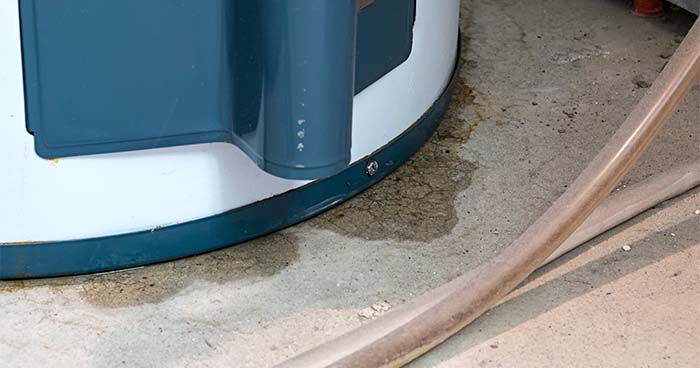
There’s nothing worse than having no hot water. It’s closely followed by having water that’s too hot, or even seeing rusty, dirty water pour out of your taps.
But it’s more than just a nuisance. If not repaired, problems with your water heater can put a stop to daily life. In extreme cases, these issues can develop into massive problems that demand expensive and time-consuming repair.
That’s why you should know how to troubleshoot a water heater. While they don’t teach you this at school, we’re here to tell you what to do when your hot water isn’t working the way it should.
This article will cover the 4 main water heater problems:
- having no hot water,
- seeing a leak,
- and having brown and rusty water.
We’ll explain what’s gone wrong inside the mechanism and how you can fix it.
I Have No Hot Water
First on our list is having no hot water at all. If you’ve turned on the faucet and there’s only cold water coming out, that’s a clear indication that you have a water heater problem. More specifically, it indicates a problem with your power, thermostat, or heating elements.

If, however, it hasn’t tripped, you’ll need to reset the high-temperature limit on your water heater. This sounds intimidating, but all you need to do is follow our steps:
- Turn off the breaker to your water heater’s power using the service panel. Make sure it’s all switched off before you proceed.
- Now, remove the access panel, insulation, and safety guard. Make sure you don’t physically touch any of the electrical wires or terminals.
- Next, you’ll need to find the high-temperature cutoff reset button. This is a bright red button located just above your upper thermostat. Press this button.
- Now, reinstall your safety guard, insulation, and access panel.
- Switch on your heater’s circuit breaker.
My Water Heater Is Leaking
If you’ve seen water leaking from your water heater, you need to act fast.
Ignoring it won’t solve the leak. In fact, it’ll allow the leak to grow, wasting you hundreds of dollars of water. Plus, you could end up with flooring and wall damage, as well as a spread of mold and mildew.

My Water Heater Is Leaking from The Top
If your water heater is leaking from the top, it suggests one of two issues. First, it could be that your hot or cold outlet pipes aren’t fastened tightly enough. Second, it may be that your temperature and pressure (T&P) valve isn’t functioning the way it should.
The first step is to find where your leak is stemming from. To do this, switch off your water heater but do not turn off the cold water inlet until you’ve found where the leak is. If you turn the cold water inlet off, it could allow the leak to disappear due to a lack of pressure. Once you’ve switched everything on again, the leak will come back.
If this isn’t working, you can wrap the pipes and fittings in tissue paper. If water seeps through the material, you’ll find where your leak is.
First, make sure the valve is closed properly. While it’s obvious, it’s easily done. Turn it as tight as you can.
If the leak is still present, follow the steps to replace your valve:
- Connect the valve to an ordinary garden hose. Make sure the other end of the hose sits outside.
- Switch off your water inlet for the tank. You can find this at the top of your water heater on the cold water line.
- Turn the valve anticlockwise to open it, and let your tank drain.
- After the tank has emptied, remove the valve altogether.
- Use joint compound or Teflon to wrap the threads of your new drain valve.
- Screw the replacement valve into position, fixing it as tight as you can manually.
- Finish up by using a wrench to tighten it roughly half a turn.
For water heaters that are leaking from the bottom, we recommend calling in a professional. Fixing these leaks can be much more involved than any leaks from the top of the water heater.

My Water Is a Dirty/Rusty Color
Having dirty colored water is an obvious issue. Your water should always be transparent and clean. If your water is a rusty color, it’s almost always down to a corroded anode rod.
This isn’t something you should ignore. The water could become contaminated, which is dangerous for your family. Plus, it can cause a leak in your water heater, which, as we know, will then need replacing altogether.
So, act fast and replace your anode rod by following the steps:
- Switch off all power to your water, including the cold water supply line.
- Locate your anode rod. Generally, you can find it on the top of your water heater toward the side of the mechanism.
- Now use a garden hose to drain about 10 percent of the water in your tank to somewhere outside.
- Let your tank cool down.
- Remove your anode rod with a socket or boxed end wrench. Don’t use liquid solutions like Liquid Wrench on any of your water heater’s components. It could contaminate your water.
- Ensure the threads are pointed downwards when installing the new anode rod. Wrap them in joint compound or plumber’s tape.
- Put the new anode rod in place, turning it manually until it can’t be turned any further.
- To finish, use a socket wrench, tightening it another half a turn. Ensure that your water heater stays in place while doing so, not twisting or turning out of place.


